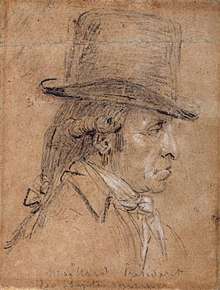September Massacres
The September Massacres were a series of killings of prisoners in Paris that occurred from 2–6 September 1792 during the French Revolution. They lasted from Sunday afternoon until Thursday evening. Charlotte Corday held Jean-Paul Marat responsible, but for Madame Roland it was Georges Danton.[1][2] Danton was also accused by the French historians Adolphe Thiers, Alphonse de Lamartine, Jules Michelet, Louis Blanc and Edgar Quinet. According to Albert Soboul there is no proof, however, that the massacres were organized by Danton or by anyone else, though it is certain that he did nothing to stop them.[3]
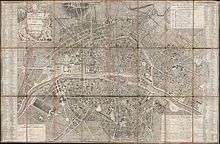 Map of Paris and the Faubourgs (1797). The La Force prison was in Le Marais on Rue Pavée, near Place des Fédérés. The Conciergerie was located on the westside of the Île de la Cité, next to the Palais de Justice. | |
| Date | September 2–6, 1792 |
|---|---|
| Location | Paris |
| Type | Massacres |
| Cause | Obsession with a prison conspiracy, desire for revenge, fear of advancing Prussians, ambiguity over who was in control |
| Organised by | Jean-Paul Marat |
| Participants | 235 Fédérés, Guardsmen and Sansculottes |
| Outcome | Half the prison population of Paris had been summarily executed |
| Deaths | 1,100–1,600 |
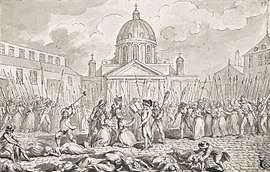
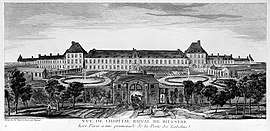
It is estimated that around 1,100–1,600 people were murdered. The action was undertaken by 235[4] Fédérés, Guardsmen and Sansculottes, with the support of Gendarmes, the latter were responsible for guarding the tribunals and prisons,[5] the Cordeliers, the Insurrectional Commune and the Revolutionary sections of Paris.[6][7][8][9] The identity of the "septembriseurs" is unknown, but a large number of them were undoubtedly Parisian national guards and provincial federates who remained in the city since their arrival in July.[10] By 6 September, half the prison population of Paris had been summarily executed. The exact number is not known; about 440–500 people had uncertain fates, including 200 Swiss soldiers.[11][12] However, the great majority (72%) of those killed were non-political prisoners – galley convicts, forgers of assignats, common criminals, women, and children; 17% were Catholic priests.[13][14] The Minister of Interior Roland accused the Commune of the atrocities. According to Georges Lefebvre the collective mentality is a sufficient explanation for the killing.[15] For Timothy Tackett "the obsession with a prison conspiracy, the desire for revenge, the fear of the advancing Prussians, the ambiguity over who was in control of a state that had always relied in the past on a centralized monarchy: all had come together in a volatile mixture of anger, fear, and uncertainty."[16]
There was a fear that foreign and royalist armies would attack Paris and that the (Swiss) inmates of the city's prisons would be freed and join them. On 1 September Legislative Assembly called for volunteers who gathered the next day on the Champs de Mars.[17] On Sunday 2 September around 13:00, Danton, a member of the provisional government, delivered a speech in the assembly: "We ask that any one refusing to give personal service or to furnish arms shall be punished with death".[18] "The bell we are about to ring is not an alarm signal; it sounds the charge on the enemies of our country". After applause he continued, "To conquer them we must dare, dare again, always dare, and France is saved!”.[19][20] His speech acted as a call for direct action among the citizens, as well as a strike against the external enemy.[21] Many believe this speech was responsible for inciting the September Massacres.
The massacre began around 14:30 in the middle of Saint-Germain-des-Prés. Within the first 20 hours more than 1,000 prisoners were killed. The next morning on 3 September the surveillance committees of the Commune, on which Marat now served, published a circular that called on provincial Patriots to defend Paris and asked that, before leaving their homes, they eliminate counter-revolutionaries. The secretary of the Commune, Jean-Lambert Tallien called on other cities to follow suit.[22] The massacres were repeated in a few other French cities; in total 65–75 incidents were reported.[23][24]
Background
The Duke of Brunswick's manifesto
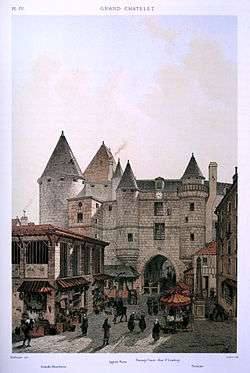
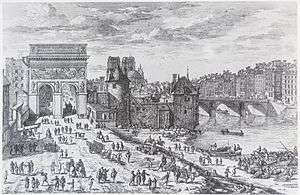
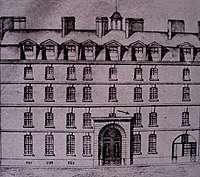
In April 1792 France declared war on the Habsburg Monarchy, prompting the War of the First Coalition. In July, an army under the Duke of Brunswick and composed mostly of Prussians joined the Austrian side and invaded France. As the army advanced, Paris went into a state of hysteria, especially after the Duke issued the "Brunswick Manifesto" on 25 July. His avowed aim was
to put an end to the anarchy in the interior of France, to check the attacks upon the throne and the altar, to reestablish the legal power, to restore to the king the security and the liberty of which he is now deprived and to place him in a position to exercise once more the legitimate authority which belongs to him.[25]
The Manifesto threatened the French population with instant punishment should it resist the Imperial and Prussian armies, or the reinstatement of the monarchy. The Manifesto was frequently described as unlawful and offensive to national sovereignty. Its authorship was frequently in doubt. Revolutionaries like Marat and Hébert suggested to concentrate on the internal enemy.[26] On 3 August Pétion and 47 sections demanded the deposition of the king.
The insurrection of the Paris commune
On the evening of 9 August 1792, a Jacobin insurrection overthrew the leadership of the Paris municipality, proclaiming a new revolutionary Commune headed by transitional authorities. The next day the insurrectionists stormed the Tuileries Palace. King Louis XVI was imprisoned with the royal family, and his authority as King was suspended by the Legislative Assembly. The next day the royalist press was silenced. A provisional executive (Conseil exécutif) was named and busied itself with reorganizing or solving questions concerning the police, justice, the army, navy and paper money but actual power now rested with the new revolutionary Commune, whose strength resided in the mobilized and armed sans-culottes, the lower classes of Paris, and fédérés, armed volunteers from the provinces that had arrived at the end of July. The 48 sections of Paris were equipped with munitions from the plundered arsenals in the days before the assault, substituting for the 60 National Guard battalions. Supported by a new armed force, the Commune dominated the Legislative Assembly and its decisions.[27] The Commune pushed through several measures: universal suffrage was adopted, the civilian population was armed, all remnants of noble privileges were abolished and the properties of the émigrés were sold. These events meant a change of direction from the political and constitutional perspective of the Girondists to a more social approach given by the Commune as expressed by Pierre-Joseph Cambon: "To reject with more efficacy the defenders of despotism, we have to address the fortunes of the poor, we have to associate the Revolution with this multitude that possesses nothing, we have to convert the people to the cause."[28]
Besides these measures, the Commune engaged in a policy of political repression of all suspected counter-revolutionary activities. Beginning on 11 August, every Paris section named surveillance committees (Committees of Vigilance), which conducting searches and making arrests.[8] It was mostly these decentralized committees, rather than the Commune as a whole, which engaged in the repression of August and September 1792. Within a few days each section elected three commissioners to take seat in the insurrectionary Commune, chaired by Maximilien Robespierre. To ensure that there was some appropriate legal process for dealing with suspects accused of political crimes and treason, rather than arbitrary killing by local committees, a revolutionary tribunal, with extraordinary powers to impose the death sentence without any appeal[29], was installed on 17 August.[30] Robespierre, who had proposed this measure, refused to preside over the tribunal, arguing that the same man ought not to be a denouncer, an accuser, and a judge.[31]:201
Already on 15 August four sections called for all priests and imprisoned suspects to be put to death before the volunteers departed. Robespierre proposed to erect a pyramid on Place Vendôme to remember the victims of 10 August. On 19 August the nonjuring priests were ordered to leave the country within two weeks, which meant before 2 September 1792. (In Paris, all monasteries were closed and soon be in use as hospitals, etc. The remaining religious orders were banned by the law of 15 August.[32]) Marat left nothing in doubt when he urged "good citizens to go to the Abbaye, to seize priests, and especially the officers of the Swiss guards and their accomplices and run a sword through them".[33] From 15 to 25 August, around 500 detentions were registered; some were sent to Orléans. Half the detentions were of nonjuring priests, but even priests who had sworn the required oath were caught in the wave.
Prussian advance and Paris reaction
On Sunday, 26 August, news reached Paris that the Prussian army had attacked the key fortress of Verdun. Roland proposed that the government should leave Paris, whereas Robespierre suggested in a letter to the sections of the Commune that they should defend liberty and equality and maintain their posts, and die if necessary.[34] The Assembly decreed that all the non-juring priests had to leave Paris within 8 days and the country within two weeks.[35] In the evening, in the presence of 350,000 people, a funeral ceremony was held in the gardens of the Tuileries for those killed while storming the Tuileries.[36]
On 28 August, the Assembly ordered a curfew for the next two days.[37] On the behest of justice minister Danton, thirty commissioners from the sections were ordered to search in every suspect house for weapons, munition, swords, carriages and horses.[38][39] Before 2 September, between 520–1,000 people were taken into custody on the flimsiest warrants. The exact number of those arrested will never be known.[40]
On 29 August, the Prussians took Verdun, gaining a clear westward path to Paris.[41] When this news arrived two days later it escalated the sense of panic. On 1 September the citizens were told to prepare themselves for the defense of the country and gather immediately on the sound of the tocsin.[42] Their imminent departure from the capital provoked further concern about the crowded prisons, now full of counter-revolutionary suspects who might threaten a city deprived of so many of its defenders.[43] Marat called for a "new blood-letting", larger than the one on 10 August. The British ambassador reported:
A party at the instigation of someone or other declared they would not quit Paris, as long as the prisons were filled with Traitors (for they called those so, that were confined in the different Prisons and Churches), who might in the absence of such a number of Citizens rise and not only effect the release of His Majesty, but make an entire counterrevolution.[44]
Throughout August, the Legislative Assembly, which had been greatly diminished as more than half of the deputies had fled since the storming of the Tuileries, had acquiesced to the activities of the Commune and its sections. On 30 August, the Girondins Roland and Marguerite-Élie Guadet tried to suppress the influence of the Commune, accused of exercising unlawful power. The Assembly, tired of the pressures, declared the Commune illegal and suggested the organization of communal elections and a doubling of the number of seats.[45][37] However, the Assembly cancelled the decree the next day at the request of Jacques-Alexis Thuriot. The balance of power was disrupted and the conflict between the Girondins and the Montagnards would influence the progress of the French Revolution.[45]
On 1 September, the gates of the city, closed the days before, were opened on the orders of Pétion, providing an opportunity for suspects to flee the capital. According to Louis-Marie Prudhomme people still profited from the opportunity on Sunday morning 2 September.[46] The Assembly decreed to arm the volunteers; a third would stay in Paris and defend the city with pikes, the others were meant for the frontier and the trenches. It further decreed that traitors who refused to participate in the defense or hand over their arms deserved death.[17] The sections, gathered in the townhall, decided to remain in Paris; Marat proposed to have Roland and his fellow Girondist Brissot arrested.[47] The Commune ordered the gates closed and an alarm gun fired. After the tocsin was rung around 2 o'clock 60,000 men enrolled for the defense of the country on the Champs de Mars.
Massacres
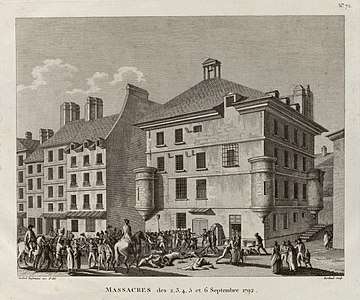
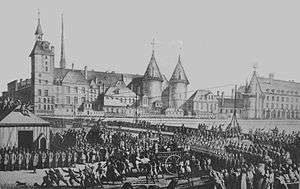

The first massacre began in quartier Latin around 2.30 on Sunday afternoon when 24 non-juring priests were being transported to the prison de l'Abbaye near the Abbey of Saint-Germain-des-Prés, after being interrogated by Billaud-Varenne in the townhall. One of the carriages, escorted by Fédérés, was attacked after an incident.[48] The Fédérés killed three men in the middle of the street, before the procession arrived at the prison. Eighteen arrested were taken inside. They then mutilated the bodies, "with circumstances of barbarity too shocking to describe" according to the British diplomatic dispatch. One of their victims was the former Minister of Foreign Affairs Armand Marc, comte de Montmorin. Roch-Ambroise Cucurron Sicard was recognized as beneficent priest and released.
Carmes prison
In the late afternoon 115 priests in the former convent of Carmelites, detained with the message they would be deported to French Guiana, were massacred in the courtyard with axes, spikes, swords and pistols by people (with a strong patois accent). They forced the priests one by one to take the oath on the Civil Constitution of the Clergy, and "swear to be faithful to the nation and to maintain liberty and equality or die defending it".[49] The priests hid in the choir and behind the altar. Several tried to escape by climbing in the trees and over the walls and escaped through Rue Cassette.[50][51]
Around five a group of 200 "Septembriseurs" came to the house of Roland on Place Dauphine to arrest him, but as he was at the Ministry they went there.
Prison de l'Abbaye
Between seven and eight o'clock in the evening the group of Fédérés, etc. was back at the Abbaye prison. The Abbaye prison was located in what is now the Boulevard Saint-Germain just west of the current Passage de la Petite Boucherie. The door was closed, but the killing was resumed after an intense discussion with Manuel, the procurator, on people's justice and failing judges.[52] He belonged to a deputation sent by the Commune to ask for compassion.[53] They were insulted and escaped with their lives.[54]
A tribunal composed of twelve people, presided by Stanislas-Marie Maillard, started the interrogating by asking the prisoner why he or she was arrested. A lie was fatal,[55] and the prisoners were summarily judged and either freed or executed.[56] Each prisoner was asked a handful of questions, after which the prisoner was either freed with the words 'Vive la nation' and permitted to leave, or sentenced to death with the words 'Conduct him to the Abbaye' or 'Let him go', after which the condemned was taken to a yard where they were immediately killed by a waiting mob consisting of men, women and children.[56]
The massacres were opposed by the staff of the prison, who allowed many prisoners to escape, one example being Pauline de Tourzel. Of about two hundred women prisoners of the Prison de l'Abbaye, only two were killed during the massacre. The Prison de l'Abbaye contained a number of prisoners formerly belonging to the royal household, as well as survivors of the Swiss Guards from the royal palace. Among them the royal governesses Marie Angélique de Mackau and Louise-Élisabeth de Croÿ de Tourzel; the ladies-in-waiting the princess de Tarente and the princess de Lamballe; the queen's ladies-maids Marie-Élisabeth Thibault and Mme Bazile; the Dauphin's nurse Mme St Brice; the princesse de Lamballe's lady's maid Mme Navarre; and the valets of the king and the dauphin, M. Chamilly and M. Hue.[56] All ten former members of the royal household were placed before the tribunals and freed from charges, with the exception of the princess de Lamballe,[56] whose death would become one of the most publicized of the September Massacres. Of the Swiss Guard prisoners 135 were killed, 27 were transferred, 86 were set free, and 36 had uncertain fates.[57]
According to George Long 122 died, 43 people were released.[58]
Conciergerie
In the early evening groups broke into another Paris prison, the Conciergerie. According to Prudhomme people sat on the stairs of the Palace of Justice watching the butchery in the courtyard.[59] Not far away Restif de la Bretonne saw the bodies piled high on Pont au Change in front of the Châtelet. The corpses were thrown in the river. He recorded the atrocities he witnessed in Les Nuits de Paris (1794).[60] Late that night they went to Tour Saint-Bernard where the forgers of assignats were jailed. The pattern of semi-formal executions followed by the popular tribunals was for condemned prisoners to be ordered "transferred" or even "released" and then taken into the prison courtyards where they would be cut down.
Before midnight the seminary Saint Firmin was visited by just four men, who killed all the seminarians. At 2.30 in the morning the Assembly was informed that most of the prisons were empty. The next morning the Assembly was still involved with the defense of the city; Hérault de Séchelles presided. It decided the other prisoners had to wait for their trial because of a temporary lack of judges.[61]
Around 4 in the afternoon Madame de Staël, as ambassadress of Sweden, who lived in Rue du Bac near Champ de Mars, tried to flee through crowded streets but her carriage was stopped and the crowd forced her to go to the Paris town hall, where Robespierre presided.[62] Late in the evening, she was conveyed home, escorted by the procurator Louis Pierre Manuel. The next day the secretary-general to the Commune of Paris, Tallien, arrived with a passport and accompanied her to the barrier.[63]
Bicêtre and Salpêtrière
On Monday morning nine o'clock, Billaud-Varenne came to the Abbaye prison and declared that the murderers should stop stealing and would get paid by the Commune. Bicêtre (for men and boys) was visited twice that day after a rumor there were thousands of rifles stored. They brought seven cannons with them. The killing went on until the next day. At dawn Salpêtrière (for women and girls) was visited.[64] There, prostitutes seem to have been released and young girls raped.[65]
The end
On Tuesday afternoon the killing stopped finally in the Abbey. Police commissioners Etienne-Jean Panis and Sergent-Marceau gave orders to wash away all the blood from the stairs and the courtyard, to spread straw, to count the corpses and to dispose of them on carts to avoid infections.[66] A contract was signed with the grave digger of the nearby Église Saint-Sulpice, Paris, who also had to purchase quicklime. On 5 September, the day of the election, it was perfectly quiet in Paris according Le Moniteur Universel.[67] There were still 80 prisoners in "La Force". On 6 September the killing finally stopped.[68][69] The next day the gates were opened, but it was impossible to travel to another départment without a passport.[70]
Contemporary reports
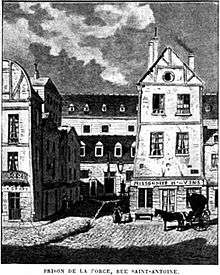
According to Galart de Montjoie, a lawyer and a royalist, in those days everyone believed the Fédérés from Marseille, Avignon and Brest were involved in the killing.[71][72][73] About 800–1000 were staying in barrack, but moved supposedly to where events would take place. It seems around 300 Fédérés from Brest and 500 from Marseille were then lodged in Cordeliers Convent.[74][75][76] Servan planned to give them military training before using them to supplement the army at the front.
The fact is that the reports of conspiracies in the prisons, however improbable, and the constant propaganda about the people’s will and the people’s anger, held everyone in a sort of stupor and gave the impression that this infamous performance was the work of the populace, whereas in reality there were not above 200 criminals.[77][78]
Though it is an ascertained fact that the perpetrators of the atrocious murders were but a few; yet it is not so clear that this work was not connived at, or consented to, by a much greater number, and those perhaps in authority; for otherwise, two or three companies of the town guard would have been sufficient to disperse those who were employed on the occasion.[79]
Perry describes the restoration of order after the events, giving the impression that the massacres may even have had a cathartic effect. He also suggests that France was plagued by fewer foreign enemies afterwards. What emerges therefore from Perry’s report is a view that, if massacres did take place, they occurred not out of spontaneous popular madness but because of comprehensible grievances.[80]
According to Adolphe Thiers, George Long and Stanley Loomis not an outburst of passion, but coldly and carefully organized.[81][82]
Rather than being proof of the unprecedented depravity of an entire population, the prison massacres were the explicable result of both the "wrath and fury" of the victims of 10 August and the machinations of the Paris Commune, who gave their tacit consent to the killings.[83] Those targeted in the attacks had not been imprisoned unjustly, but had been suspected of having aided the court in its negotiations with foreign princes. In a similar way to Perry, Williams emphasizes the understandable impatience of the people, who had been kept waiting too long for justice after the August Days, when husbands, brothers and fathers had been killed.[84]
Numbers
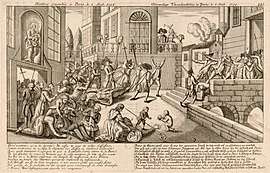
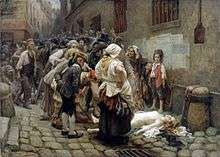
According to Pierre Caron there were almost 2,800 prisoners in early September. Between 1,250–1,450 prisoners were condemned and executed. According to Caron and Bluche 70% of the victims were killed in a 20-hour interval.[85] Among the victims were 223 nonjuring Catholic priests and (arch)bishops who refused to submit to the Civil Constitution of the Clergy, 81 Swiss guards, and 40–80 political suspects, mostly royalists, aristocrats and some former judges and ministers[86] including the queen's best friend, the Princesse de Lamballe, the only political victim in "La petite Force".[87]
The lives of about 1,250–1,600 prisoners brought before the people's courts were saved.[88] In a few cases people were acclaimed as "patriots" by Robespierre, Tallien, Desmoulins and Danton.[89][90] Several prisoners for debts or alimony were released by Manuel or by the police before 2 September.[91] Louise-Élisabeth de Croÿ de Tourzel was released from Port-Royal Abbey, Paris on order of the Commune.
A total of nine prisons were violently entered during the five days of the massacres before the killings concluded on the night of 6–7 September; four were not visited (Sainte-Pélagie Prison, Prison Saint-Lazare, Tour du Temple and palais Bourbon). About 700 surviving Swiss soldiers, locked up in Palais Bourbon, marched to the townhall to take the oath and joined the volunteers.[68][92] After initially indiscriminate slayings, ad hoc popular tribunals were set up to distinguish between "enemies of the people" and those who were innocent, or at least were not perceived as counter-revolutionary threats. In spite of this attempted sifting, an estimated three-quarters of the 1,250–1,450 killed were not counter-revolutionaries or "villains", but included all the galley convicts, forgers of assignats, 37 women (including the Princess de Lamballe and the book-seller Marie Gredeler, who was accused of murder) and 66 children.[93][94] Some priests and women were of age, about prostitutes or insane not much is known.[14]
In Paris in the Terror, Stanley Loomis reports that during the massacre at the prison-hospital of Bicêtre, 33 boys aged between 12 and 18 were murdered by a group of 1,500–2,000 people.[95][96][97] Mayor Pétion did not have much influence discussing humanity with them.[98] Loomis also reported that afterwards "girls as young as ten" were murdered in Salpêtrière institution for women, mentally insane and prostitutes.[99] The number of victims is exactly known: 35 women, including 23 underaged.[100]
Killings outside Paris
On 3 September the surveillance committees of the Commune, on which Marat now served, published a circular that called on provincial Patriots to defend Paris and asked that, before leaving their homes, they eliminate counter-revolutionaries. Marat advised the entire nation "to adopt this necessary measure".[101]
A circular letter was sent to regional authorities by Deforgues, an assistant of Danton, and Tallien, the secretary of the Paris Commune, advising that "ferocious conspirators detained in the prisons had been put to death by the people".[102][103][104]
The Girondins afterwards made much of this circular, but there is no evidence that it had any influence. As before, murders in the provinces continued: the blood-letting did not cease until the countryside was purged. Smaller-scale executions took place in Reims, Meaux, and Lyon on 2, 4 and 9 September. Most notable was the killing of 44 political prisoners near Château de Versailles transported from the High Court in Orléans back to Paris, the 9 September massacres.[24] The next day Brissot wrote in "Le Patriote français", his newspaper: "No doubt you will be told that it is a vengeance of the people; it will be a slander. The people were not involved in this event."[105]
Official role
According to Timothy Tackett: "For a period of some 48 hours between the 29th and 31 August the whole of Paris was systematically searched by the national guard for lurking conspirators and hidden arms.[106] By that time section assemblies were already passing motions demanding "the death of conspirators before the departure of citizens".[107]
On 31 August the Committee of Vigilance was created with Panis and Sergent-Marceau. According to Madame de Staël on 31 August "it was already known, that only those who were destined to be massacred were sent to that prison [of the Abbey]."[108]
On 1 September the Commune declared a state of emergency by decreeing that on the following day the tocsin should be rung, all able-bodied citizens convened in the Champ de Mars.[17] On Sunday 2 September the 1792 French National Convention election started. Robespierre publicly accused Brissot and the Brissotins of plotting with the Duke of Brunswick.[109] Marat was appointed as one of the six additional members of the Committee of Vigilance, but without the approval of the Executive Council.[110]
According to Adolphe Thiers on Sunday morning 2 September: "The keeper of the Abbaye sent away his children in the morning. Dinner was served to the prisoners two hours before the accustomed time; and the knives were taken from their plates."[111][112]
Such municipal and central government as existed in Paris in September 1792 was preoccupied with organizing volunteers, supplies, and equipment for the armies on the threatened frontiers. Accordingly, there was no attempt to assuage popular fears that the understaffed and easily accessed prisons were full of royalists who would break out and seize the city when the national guards and other citizen volunteers had left for the war. According to Madame Roland Danton responded to an appeal to protect the prisoners with the comment: "To hell with the prisoners! They must look after themselves."[113][114][115] On 3 September Roland said: "Yesterday was a day that we should perhaps throw a veil on." The other member of the provisional government – Clavière, Lebrun-Tondu, Monge and Servan, involved in organizing the country did not do much to stop the killing, or could not foresee or prevent these excesses. Mayor Pétion de Villeneuve turned a blind eye when he visited Bicêtre.[116] Olympe de Gouges and Brissot's newspaper were the only ones condemning the September murders.
Debate in the Convention
The Brissotins in the Convention first attacked Danton; he was asked to resign as minister on the 25th but forced to step down on 9 October. He kept his seat in Convention as deputy. Then the Brissotins decided to attack Robespierre and Marat.
On 29 October 1792, the Convention held an afterthought. Jean-Baptiste Louvet de Couvray accused Robespierre of creating a personality cult and interested in governing.[117] Robespierre was taken by surprise and had to be defended by Danton.[118] Robespierre was given eight days to reply. Marat was accused of being asocial and establishing dictatorship. On 5 November Robespierre stated that Marat had visited him only once since January.[119] He admitted the arrests [at the end of August] were illegal, as illegal as the revolution, the fall of the monarchy and the Bastille.[120] He asked the convention: "Citizens, did you want a revolution without revolution?" Robespierre, Danton and Marat insisted that the "new bloodletting" had been a spontaneous popular movement. Their opponents, the Girondins, spoke of a systematically planned conspiracy.[121] Roland and Louvet were no longer admitted to the Jacobin Club.[122]
The political repercussions first injured the Girondins (who seemed too moderate) and later the Jacobins (who seemed too bloodthirsty).[123] A new mayor Nicolas Chambon was installed on 1 December 1792. On 20 January 1793 Robespierre defended the massacres as necessary.[124] Louis XVI was guillotined on the next day.
It was Servan's proposal to bring armed volunteers from the provinces. He was arrested during the Terror, but released in February 1795. In 1796 24 or 39 craftsmen and small businessmen were accused;[125] though only three were condemned.[126] The vinegar maker Damiens got twenty years of imprisonment imposed.
Martyrs
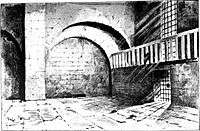
A group of 115 churchmen killed in the Carmes Prison was beatified by Pope Pius XI on 17 October 1926. Among the martyrs were Pierre-Louis de la Rochefoucauld, bishop of Saintes; Jean-Marie du Lau d’Alleman, archbishop of Arles; François-Joseph de la Rochefoucauld, bishop of Beauvais; and Ambroise Chevreux, the last superior-general of the monastic Congregation of Saint Maur.[127]
See also
- The Legislative Assembly and the fall of the French monarchy
Notes and citations
- Hauck, Carolin; Mommertz, Monika; Schlüter, Andreas; Seedorf, Thomas (9 October 2018). Tracing the Heroic Through Gender. Ergon Verlag. ISBN 9783956504037.
- Lawday, David (6 July 2010). The Giant of the French Revolution: Danton, A Life. Open Road + Grove/Atlantic. ISBN 9780802197023.
- "Georges Danton - Danton's Committee of Public Safety". Encyclopedia Britannica.
- Granier de Cassagnac, A. (Adolphe) (5 July 1860). "Histoire des Girondins et des massacres de septembre d'après les documents officiels et inédits, accompagnée de plusieurs fac-similé". Paris : E. Dentu – via Internet Archive.
- "Collection Complète des Lois, Décrets, Ordonnances, Réglements, et Avis du Conseil-d'État". A. Guyot. 5 July 1824.
- P. Caron (1935), p. 107, 114
- S. Schama, p. 611
- "F. Furet & M. Ozouf (1989) A Critical Dictionary of the French Revolution, p. 139" (PDF).
- Adolphe Granier de Cassagnac (1862?) Histoire des Girondins et des Massacres de Septembre, p. ?
- "Septembre 1792 : de la rumeur au massacre". www.lhistoire.fr.
- Bluche, Frédéric (1 January 1986). Septembre 1792 : logiques d'un massacre. Robert Laffont (réédition numérique FeniXX). ISBN 9782221178560.
- L. Madelin, p. 256
- Gwynne Lewis (2002). The French Revolution: Rethinking the Debate. Routledge. p. 38. ISBN 9780203409916.
- Frédéric Bluche (1986) Septembre 1792 : logiques d'un massacre, p. 235
- Georges Lefebvre, The French Revolution: From its Origins to 1793 (2001) p.236
- "Tackett, Timothy (2011) "Rumor and Revolution: The Case of the September Massacres", French History and Civilization Vol. 4, pp. 54–64" (PDF).
- "Collection Complète des Lois, Décrets, Ordonnances, Réglements, et Avis du Conseil-d'État". A. Guyot. 5 July 1824.
- "Danton (2 septembre 1792) - Histoire - Grands discours parlementaires - Assemblée nationale". www2.assemblee-nationale.fr.
- "I. "Dare, Dare Again, Always Dare" by Georges Jacques Danton. Continental Europe (380-1906). Vol. VII. Bryan, William Jennings, ed. 1906. The World's Famous Orations". www.bartleby.com.
- Danton, Georges-Jacques (1759-1794) Auteur du texte (5 July 1910). "Discours de Danton / édition critique par André Fribourg" – via gallica.bnf.fr.
- Mantel, Hilary (6 August 2009). "Hilary Mantel · He Roared: Danton · LRB 6 August 2009". London Review of Books.
- F. Furet and M. Ozouf, eds. A Critical Dictionary of the French Revolution (1989), pp. 521–22
- P. Caron (1935) Les massacres de Septembre, p. 363-394. Part IV covers comparable events in provincial cities that transpired from July to October 1792.
- P. McPhee (2016) Liberty or Death, p. 162
- Arno J. Mayer (2000). The Furies: Violence and Terror in the French and Russian Revolutions. Princeton U.P. p. 554. ISBN 0691090157.
- Cross, E. (2011). "The Myth of the Foreign Enemy? The Brunswick Manifesto and the Radicalization of the French Revolution". French History. 25 (2): 188–213. doi:10.1093/fh/crr030 – via www.academia.edu.
- Bergeron, Louis, Le Monde et son Histoire, Paris, 1970, Volume VII, Chapter VII, p. 324
- L. Bergeron (1970), p. 325.
- In 1815, a secretary of the Convention, writing under the pseudonym Proussinale, published some remarkable details about the procedure, Histoire secrète du tribunal révolutionnaire, par M. de Proussinalle, Band 1, p. 2-6
- Gilchrist, John Thomas (5 July 1971). "Press in the French Revolution". Ardent Media.
- Ruth Scurr (17 April 2007). Fatal Purity: Robespierre and the French Revolution. Henry Holt and Company. ISBN 978-0-8050-8261-6.
- L. Bergeron, p. 326
- S. Schama, p. 630; L'Amie du peuple, no 680
- Jean Massin (1959) Robespierre, p. 133-134
- Le Moniteur universel, t. XIII, n° 241, du 28 aôut, p. 540
- [Le Moniteur universel, t. XIII, n° 244, du 31 aôut, p. 572<]
- J. Massin (1959), Robespierre, p. 132.
- S. Schama, p. 626
- "Collection Complète des Lois, Décrets, Ordonnances, Réglements, et Avis du Conseil-d'État". A. Guyot. 5 July 1824.
- S. Loomis, p. 77
- Parker, Geoffrey (2008). The Cambridge Illustrated History of Warfare. New York: Cambridge University Press. p. 195. ISBN 978-0-521-73806-4.
- Le Moniteur universel, t. XIII, n° 248, du 5 septembre, p. 590
- Cobb, R. & C. Jones (1988) The French Revolution. Voices from a momentous epoch 1789–1795, p. 159
- Oscar Browning, ed., The Despatches of Earl Gower (Cambridge University Press, 1885), 213–16, 219–21, 223–28.
- J. Israel (2014), Revolutionary Ideas, p. 267-268.
- L. Bluche, p. 258
- Bluche, Frédéric (1 January 1986). Septembre 1792 : logiques d'un massacre. Robert Laffont (réédition numérique FeniXX). ISBN 9782221178560.
- The history of the French revolution, tr. with notes by Marie Joseph L. Adolphe Thiers, p. 144
- F. Bluche, p. 219
- Lapize de La Pannonie, Pierre de Auteur du texte (5 July 1913). "Les Massacres du 2 septembre 1792 à la prison des Carmes à Paris / Abbé Pierre de Lapize de La Pannonie" – via gallica.bnf.fr.
- S. Loomis, p. 79
- F. Bluche, p. 56-60
- L. Blanc (1855) Histoire de la Révolution Française, vol VII, p. 163
- Oscar Browning, ed., The Despatches of Earl Gower (Cambridge University Press, 1885), 213–16, 219–21, 223–28.
- Blanc, Louis (5 July 1855). "Histoire de la révolution française". Langlois et Leelereq.
- Hardy, B. C. (Blanche Christabel), The Princesse de Lamballe; a biography, 1908, Project Gutenberg
- Leborgne, Dominique, Saint-Germain-des-Prés et son faubourg, p. 40, Éditions Parigramme, Paris, 2005, ISBN 2-84096-189-X
- France and Its Revolutions: A Pictorial History 1789–1848 by George Long, p. 199-202
- F. Bluche, p. 260
- "The September Massacres witnessed by Restif de la Bretonne".
- Le Moniteur universel, t. XIII, n° 248, du 5 septembre, p. 607
- Staël (Anne-Louise-Germaine), Madame de (5 July 1818). "Considerations on the Principal Events of the French Revolution". Baldwin, Cradock, and Joy.
- Ballard, Richard (14 October 2011). A New Dictionary of the French Revolution. I.B.Tauris. ISBN 9780857720900.
- F. Bluche, p. 193
- "HÔPITAL ET CIMETIÈRE (disparu) DE LA SALPÊTRIÈRE (Paris) - Tombes Sépultures dans les cimetières et autres lieux". www.tombes-sepultures.com.
- L. Blanc, p. 182
- Le Moniteur universel, t. XIII, n° 248, du 5 septembre, p. 613
- Le Moniteur universel, t. XIII, n° 251, du 7 septembre, p. 621
- F. Bluche, p. 72, 193
- Le Moniteur universel, t. XIII, n° 248, du 7 septembre, p. 629
- Histoire de la conjuration de Robespierre, p. 81. Paris, les marchands de nouveautés, 1795 ; Chez Maret, an IV(1796).
- F. Bluche, p. 233
- "L.M. Ternaux (1863) Histoire de la Terreur, 1792–1794, Tome III, p. 126, 224" (PDF).
- Hampson, Norman (1978) Danton (New York: Basil Blackwell), pp. 71–72.
- S. Schama, p. 605, 611
- Blanc, Jean Joseph Louis (5 July 1855). "Histoire de la révolution Française". Langlois et Leclercq.
- The memoirs of Madame Roland, p. ? (London: Barrie & Jenkins, translated by Evelyn Shuckburgh (1989)
- Histire de la conjugation de Maximilien Robespierre, p. 81
- Perry, Sampson (5 July 1796). "An Historical Sketch of the French Revolution: Commencing with Its Predisposing Causes, and Carried on to the Acceptation of the Constitution, in 1795". H. D. Symonds.
- "Rachel Rogers (2012) Vectors of Revolution : The British Radical Community in Early Republican Paris, 1792–1794, p. 376. Université Toulouse le Mirail".
- "France and Its Revolutions: A Pictorial History 1789-1848". Charles Knight. 5 July 1850 – via Internet Archive.
- S. Loomis, p. 74, 81, 96, 143, 207
- Helen Maria Williams’ Letters from France (1792–93), Letter IV, p. 191
- "Rachel Rogers (2012) Vectors of Revolution: The British Radical Community in Early Republican Paris, 1792–1794, p. 402. Université Toulouse le Mirail".
- F. Bluche, p. 192
- P. Caron (1935) Les Massacres de Septembre, p. 94-99; 101–102
- Boussemart, Charles (17-18 ? ; révolutionnaire) Auteur du texte (5 July 1792). "Grande trahison de Louis Capet : complot découvert, pour assassiner, dans la nuit du 2 au 3 de ce mois, tous les bons citoyens de la capitale, par les aristocrates et les prêtres réfractaires, aidé des brignads et des scélérats, détenus dans les prisons de Paris ([Reprod.]) / [par Charles Boussemart,...]" – via gallica.bnf.fr.
- P. Caron, p. 99
- M. J. Sydenham The French Revolution, B.T. Batsford Ltd, 1965, p. 121
- L. Michelet, tome IV, p. 121
- Granier de Cassagnac, A. (Adolphe) (5 July 1860). "Histoire des Girondins et des massacres de septembre d'après les documents officiels et inédits, accompagnée de plusieurs fac-similé". Paris : E. Dentu – via Internet Archive.
- "L.M. Ternaux (1863) Histoire de la Terreur, 1792–1794, d'après des documents authentiques et inédits. Tome III, p. 10, 298" (PDF).
- P. Caron (1935) Les Massacres de Septembre, p. 95
- Coulter, Ann (7 June 2011). Demonic: How the Liberal Mob Is Endangering America. Crown Publishing Group. ISBN 9780307885364.
- S. Loomis, p. 83
- F. Bluche, p. 70
- L.M. Ternaux, p. 295-296
- "Mémoires sur les journées de septembre, 1792". Baudouin frères. 5 July 1823.
- Loomis, Stanley (1964). Paris in the Terror. New York: Dorset Press. ISBN 0-88029-401-9.
- F. Bluche, p. 454
- Davidson, Ian (25 August 2016). The French Revolution: From Enlightenment to Tyranny. Profile Books. ISBN 9781847659361.
- Beale, Joseph H. (1884). "The French Revolution". Charles Knight's Popular History of England. p. 725. in Beale, Joseph H. (1884). Gay's Standard History of the World's Great Nations. 1. W. Gay and Company.
- Gorton, John (5 July 1828). "A general biographical dictionary: containing a summary account of the lives of eminent persons of all nations, previous to the present generation". Hunt and Clarke.
- "Jean-Lambert Tallien". www.nndb.com.
- F. Bluche, p. 256
- "T. Tackett, p. 63
- S. Schama, p. 631
- Staël (Anne-Louise-Germaine), Madame de (5 July 1818). "Considerations on the Principal Events of the French Revolution". Baldwin, Cradock, and Joy.
- Hardman, John (5 July 1999). Robespierre. Longman. ISBN 9780582437555.
- Jacques, De Cock (1 December 2013). Action politique de Marat pendant la Révolution: (1789-1793). fantasques éditions. ISBN 9782913846319.
- Thiers, Marie Joseph L. Adolphe (5 July 1845). "The history of the French revolution, tr. with notes".
- Granier de Cassagnac, A. (Adolphe) (5 July 1860). "Histoire des Girondins et des massacres de septembre d'après les documents officiels et inédits, accompagnée de plusieurs fac-similé". Paris : E. Dentu – via Internet Archive.
- Biard, Michel; Leuwers, Hervé (18 May 2016). Danton: Le mythe et l'histoire. Armand Colin. ISBN 9782200615277.
- M. J. Sydenham The French Revolution, B. T. Batsford Ltd, 1965, p. 121
- R. Scurr (2006) Fatal Purity. Robespierre and the French Revolution, p. 243?
- "Mémoires sur les journées de septembre, 1792". Baudouin frères. 5 July 1823.
- S. Schama p. 649
- R. Scurr (2006) Fatal Purity. Robespierre and the French Revolution, p. ?
- Robespierre, Maximilien (5 July 1840). "Oeuvres". Worms.
- "The Eclectic Magazine of Foreign Literature, Science, and Art". Leavitt, Trow, & Company. 5 July 1844.
- J. Israel (2014) Revolutionary ideas, p. 271, 273
- Bouloiseau, Marc (17 November 1983). The Jacobin Republic 1792-1794. Cambridge University Press. ISBN 9780521289184.
- Georges Lefebvre, The French Revolution: From its Origins to 1793 (1962), pp. 241–44, 269
- Robespierre, Maximilien (5 July 1793). "Oeuvres de Maximilien Robespierre". E. Leroux.
- P. Caron (1935), p. 107
- F. Bluche, p. 187, 210
- "Bienheureux Martyrs des Carmes". Nominis (in French). Catholic Church in France. Retrieved 31 August 2018.
Bibliography
- Blanc, L. (1855) Histoire de la Révolution Française, vol. VII. FUREURS DE LA GIRONDE
- Bluche, F. (1986) Septembre 1792 : logiques d'un massacre.
- Caron, P. (1935) Les Massacres de Septembre
- Israel, J. (2014) Revolutionary Ideas, p. 267-277
- Loomis, S. (1964) Paris in the Terror. New York: Dorset Press. ISBN 0-88029-401-9 online
- Scott, S.F. & B. Rothaus, eds. (1985) Historical Dictionary of the French Revolution 1789–1799. Vol. 2 pp. 891–97.
- Tulard, J. & J-F. Fayard and A. Fierro (1998) Histoire et Dictionnaire de la Révolution Française. ISBN 2-221-08850-6
Further reading
- F. Furet (1989) Terror. In: A critical dictionary of the French Revolution
- Hibbert, Christopher (1980) The Days of the French Revolution. William Morrow, New York.
- Schama, Simon (1992) Citizens: A Chronicle of the French Revolution pp. 629–39.
- Tackett, Timothy (2011) "Rumor and Revolution: The Case of the September Massacres", French History and Civilization Vol. 4, pp. 54–64.
Eyewitnesses
- Madame de Staël (1818) Considerations on the Principal Events of the French Revolution, Band 2, p. 68
- La Vérité toute entière sur les vrais acteurs de 2. Septembre 1792 par Jean Claude Hippolyte Méhée de la Touche
- Histoire de la conjugation de Maximilien Robespierre
- Nicolas-Edme Restif de la Bretonne (1793) Les nuits de Paris, ou Le spectateur nocturne, p. 371-394
- The September Massacres witnessed by Earl Gower, a British diplomat
Fictional accounts
- Dickens, Charles, A Tale of Two Cities (1859).
- Henty, George Alfred, In the Reign of Terror.
- Neville, Katherine, The Eight (1988).
External links
- Eric Hazan (2012) A People's History of the French Revolution. June to August 1792. The journée of 20 June, the Brunswick Manifesto, the taking of the Tuileries, the end of the monarchy, the September massacres
- "The September Massacres : 2–7 Sept. 1792" (archived link)
- Thomas Carlyle on the September Massacres
- Massacre de 2, 3, 4, 5 et 6 septembre (print)
- Les massacres de Septembre (1910) by Lenotre, G
